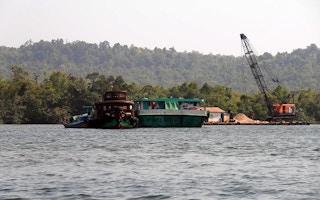What if Asia’s construction industry used only recycled sand and stopped sourcing it from the region’s environmentally sensitive beaches, mangroves and river banks?
A new mobile processing plant from Ireland-based machinery company CDE uses waste left over from demolished buildings and construction sites, and turns it into manufactured sand—called m-sand—which can be used for other projects.
“There’s a huge amount of construction and destruction in this part of the world. Having the scope to try and make that a circular process is really important,” said British High Commissioner to Singapore Scott Wightman, at the recent CleanEnviro Summit Singapore (CESS). “The fact is, with the amount of investment that’s required for infrastructure over the coming years, there just isn’t enough natural sand to sustain this growth. Manufactured sand is part of the answer.”
CDE’s regional branch, CDE Asia, is working with Malaysian infrastructure developer Batu Tiga Quarry Sdn Bhd, YTL Corporation Berhad’s quarry division, to develop and promote manufactured sand produced from the company’s quarries. The intention is to replace the use of natural sand—which is fast disappearing in Southeast Asia—in construction. Recycled sand, manufactured using technology such as CDE’s, can be used in major infrastructure such as mortar, brick work and concrete road construction.
According to YTL Quarry Group’s executive director Patrick James Pereira, the benefits of manufactured sand extend beyond its role as an environmentally friendly alternative to natural sand. While the latter’s quality, availability and price may fluctuate, manufactured sand is engineered to a certain standard, making it more consistent and easily used in cement mixers.
“
With the amount of investment that’s required for infrastructure over the coming years, there just isn’t enough natural sand to sustain this growth.
Scott Wightman, British High Commissioner to Singapore
“Typically in most countries, waste [from construction and excavation] is stockpiled and can’t be burnt or incinerated. Eventually cities pay money to move and throw away that material,” added Manish Bhartia, managing director of CDE Asia. “Now there’s an opportunity to recycle that material, which serves our purpose of addressing the sand shortage problem.”
Asia’s sand crisis
Urban growth and development booms in Asia over recent years have led to the plundering of riverbeds, sand pits and mangroves, disrupting natural ecosystems and leaving a trail of illegal mining and pollution in its wake. Pressured by increasing demand for the natural resource, sand has become a contentious commodity caught in the crossfire between governments and green groups pushing for more environmental responsibility.
According to market-research firm Freedonia Group, in 2014 alone 70 per cent of all sand mined for construction was used in Asia. Vietnam, the second-largest producer of cement in Asia after China, is predicted to run out of the commodity by 2020.
Across the region, the detrimental impact of excessive mining on the environment has led to bans on sand exports after protests from environmentalists. In China, its largest freshwater lake, Poyang Lake, is getting drastically shallow due to sand mining, while in Indonesia, illegal extraction of sand has led to the disappearance of whole islands.
Last year, Cambodia banned all exports of sand to Singapore after environmental groups complained that sand was still being exported illegally despite a temporary ban put in place the year before. Resource-scarce Singapore is the world’s largest importer of sand per capita, having expanded by 130 square kilometres in land area over in the last 40 years. The small city-state is Cambodia’s number one market for sand, having imported the material for decades to reclaim land along its coasts.
M-sand: How much better is it for the environment?
In light of the clampdown on sand exports to Singapore, attempts have been made to reduce reliance on sand and natural resources. In 2010, YTL completed its project with Resorts World Sentosa, which used manufactured sand supplied from the concrete supplier in its integrated resort. YTL’s buildings in Malaysia are also made entirely from manufactured sand, according to Pereira.
Collaboration with CDE to bring high-quality manufactured sand to Asia has the potential to change the game and divert sourcing from the region’s riverbeds. However, while this promotes a more sustainable, zero-waste system, how much more eco-friendly is this alternative, considering the footprint left behind by the whole manufacturing process?
“Typically, when sand is processed in countries [in the region], it’s done in a shabby way, wasting oil, water and dirtying the river, making it impossible for marine life to survive. This is because they want to produce it at the lowest possible cost,” said Bhartia.
He added that packaging CDE’s technology into its mobile plants enables it to run on less energy, noting that this made it more sustainable for many developing countries in the region that lack reliable access. The power needed to fuel CDE’s mobile plants is kept to less than 1 kilowatt per tonne of material. The system also recycles 95 per cent of water used.
“Our entire technology is not only producing alternative sand; we’ve also taken care of the whole environment,” said Bhartia.











